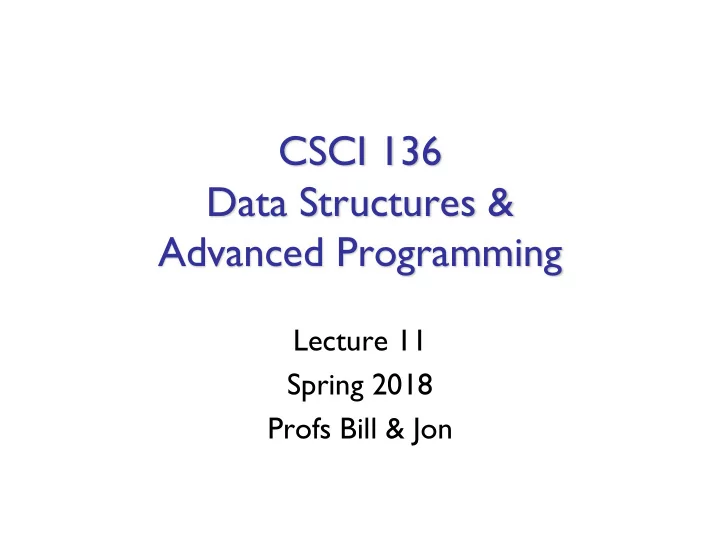

CSCI 136 Data Structures & Advanced Programming Lecture 11 Spring 2018 Profs Bill & Jon
Administrative Details • Lab 4 • A wrong version of LinkedList.java was posted on the course website. • If you downloaded the file, please delete it. If you have it open on your browser, please refresh your browser. (The honor code applies here.) • Your starter repo contains the correct version, so you don't have to do anything if you haven't checked out the file on the website • Fill out the Google form by 10am
Last Time • Singly Linked List Implementations • Doubly Linked List • Lab 4: Dummy Nodes
Today • Assertions • SLL improvements? • Tail Pointer • Circularly Linked Lists • Doubly Linked Lists – with recursion! • Search • Linear • Binary 4
Assertions • Pre and post condition comments are useful to us as programmers, but they aren’t enforced • Assertions are a language feature that lets us test assumptions about our code • Structure 5 has an Assert class • Java language now has an assert keyword
Assertions • Structure5: static method that “just works” • Assert.pre(<condition>, “Error Msg”); • Java assert : must run code with -ea flag • assert <condition>; • assert <condition> : “Error Msg”; java -ea AssertionTest
Linked List Improvements: tail • Which of these List methods would be faster if the SLL class had a SLLN tail member variable? • getLast() • addLast() • removeLast() head tail <null> List element List 7
Linked List Improvements: tail • After adding a tail to SLL : • addLast() and getLast() become O(1) • removeLast() is not improved. Why? • We need to know the SLLN before tail so we can reset tail • Side effects • We now have three cases to consider in method implementations • Think about add(int i, E o) – empty list, head==tail , head!=tail 0 head tail 0 head tail 0 head tail 8 null null null null
Linked List Improvements: CircularlyLinkedLists • Use next reference of last element to reference head of list • Replace head reference with tail reference • Access head of list via tail.next() • ALL operations on head are fast! • addLast() is still fast • Only modest additional complexity in implementation • Can “cyclically reorder” list by changing tail node • Question: What’s a circularly linked list of size 1? 9
DoublyLinkedLists • Nodes keep reference/links in both directions • DLL keeps head and tail references • DoublyLinkedListNode instance variables: • DLLN<E> next; DLLN<E> prev; E value; count head tail value p n 3 Rhonda Rhoda Rhory Figure 9.7, Bailey pg. 202 10
DoublyLinkedLists • Space overhead is proportional to number of elements • Still O(n) like SLL and Vector • ALL operations on tail (including removeLast) are fast! • Additional complexity in each list operation • Example: add(E d, int index) • Four cases to consider now: – empty list – add to front – add to tail – add in middle 11
public class DoublyLinkedNode<E> { protected E data; protected DoublyLinkedNode<E> nextElement; protected DoublyLinkedNode<E> previousElement; // Constructor inserts new node between existing nodes public DoublyLinkedNode(E v, DoublyLinkedNode<E> next, DoublyLinkedNode<E> previous) { data = v; nextElement = next; if (nextElement != null) nextElement.previousElement = this; previousElement = previous; if (previousElement != null) previousElement.nextElement = this; }
DoublyLinkedList Add Method public void add(int i, E o) { if (i == 0) { addFirst(o); } else if (i == size()) { addLast(o); } else { // Find items before and after insert point DoublyLinkedNode<E> before = null; DoublyLinkedNode<E> after = head; // search for ith position while (i > 0) { before = after; after = after.next(); i--; } // before, after refer to items in slots i-1 and i // continued on next slide
DoublyLinkedList Add Method // Note: Still in “else” block! // before, after refer to items in slots i-1 and i // create new value to insert in correct position. // Use DLN constructor that takes parameters // to set its next and previous instance variables DoublyLinkedNode<E> current = new DoublyLinkedNode<E>(o,after,before); count++; // adjust size // make after and before value point to new value before.setNext(current); after.setPrevious(current); // Note: These lines aren’t needed---why? } }
Lab 4: Any Questions? count head tail value p n count head tail value p n 3 3 Rhonda Rhonda Rhoda Rhoda Rhory Rhory Figure 9.7, Bailey pg. 202 Bailey pg. 215
Lists and Recursion • Let’s implement DLL’s int indexOf(E value) recursively Questions: • What is the base case? • How do we call indexOf(E value) on a smaller version of the list? • Nodes are recursive; List interface hides implementation details • Prove by induction that recIndexOf() is O(n) recursive calls in the worst case
Recommend
More recommend